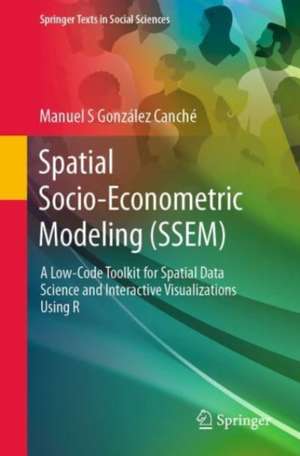Spatial Socio-econometric Modeling (SSEM): A Low-Code Toolkit for Spatial Data Science and Interactive Visualizations Using R: Springer Texts in Social Sciences
Autor Manuel S. González Canchéen Limba Engleză Paperback – 2 iul 2023
With the primary goal of expanding access to spatial data science tools, this book offers dozens of minimal or low-code functions and tutorials designed to ease the implementation of fully reproducible Spatial Socio-Econometric Modeling (SSEM) analyses. Designed as a University of Pennsylvania Ph.D. level course for sociologists, political scientists, urban planners, criminologists, and data scientists, this textbook equips social scientists with all concepts, explanations, and functions required to strengthen their data storytelling. It specifically provides social scientists with a comprehensive set of open-access minimal code tools to:
•Identify and access place-based longitudinal and cross-sectional data sources and formats
•Conduct advanced data management, including crosswalks, joining, and matching
•Fully connect social network analyses with geospatial statistics
•Formulate research questions designed to account for place-based factors in model specification and assess their relevance compared to individual- or unit-level indicators
•Estimate distance measures across units that follow road network paths
•Create sophisticated and interactive HTML data visualizations cross-sectionally or longitudinally, to strengthen research storytelling capabilities
•Follow best practices for presenting spatial analyses, findings, and implications
•Master theories on neighborhood effects, equality of opportunity, and geography of (dis)advantage that undergird SSEM applications and methods
•Assess multicollinearity issues via machine learning that may affect coefficients' estimates and guide the identification of relevant predictors
•Strategize how to address feedback loops by using SSEM as an identification framework that can be merged with standard quasi-experimental techniques like propensity score models, instrumental variables, and difference in differences
•Expand the SSEM analyses to connections that emerge via social interactions, such as co-authorship and advice networks, or any form of relational data
The applied nature of the book along with the cost-free, multi-operative R software makes the usability and applicability of this textbook worldwide.
Preț: 596.19 lei
Preț vechi: 701.40 lei
-15% Nou
Puncte Express: 894
Preț estimativ în valută:
114.08€ • 118.88$ • 94.46£
114.08€ • 118.88$ • 94.46£
Carte tipărită la comandă
Livrare economică 03-17 aprilie
Preluare comenzi: 021 569.72.76
Specificații
ISBN-13: 9783031248566
ISBN-10: 3031248562
Pagini: 503
Ilustrații: XLI, 503 p. 118 illus., 96 illus. in color.
Dimensiuni: 155 x 235 mm
Greutate: 0.76 kg
Ediția:1st ed. 2023
Editura: Springer International Publishing
Colecția Springer
Seria Springer Texts in Social Sciences
Locul publicării:Cham, Switzerland
ISBN-10: 3031248562
Pagini: 503
Ilustrații: XLI, 503 p. 118 illus., 96 illus. in color.
Dimensiuni: 155 x 235 mm
Greutate: 0.76 kg
Ediția:1st ed. 2023
Editura: Springer International Publishing
Colecția Springer
Seria Springer Texts in Social Sciences
Locul publicării:Cham, Switzerland
Cuprins
Part I Conceptual and Theoretical Underpinnings.- Chapter 1. SPlaces.- Chapter 2. Operationalizing Splaces.- Chapter 3. Data Formats, Coordinate Reference Systems, and Differential Privacy Frameworks.- Part II Data Science SSEM Identification Tools: Distances, Networks, and Neighbors.- Chapter 4. Access and Management of Spatial or Geocoded Data.- Chapter 5. Distances.- Chapter 6. Geographical Networks as Identification Tools.- Part III SSEM Hypothesis Testing of Cross-sectional and Spatio-temporal Data and Interactive Visualizations.- Chapter 7. SODA: Spatial Outcome Dependence or Autocorrelation.- Chapter 8. SSEM Regression Based analyses.- Chapter 9. Visualization, Mining, and Density Analyses of Spatial and Spatio-temporal Data.- Chapter 10. Final Words.- Glossary.- Index.
Notă biografică
Manuel S. González Canché holds a tenured professorship at the University of Pennsylvania. His professional training in Computer Science, Biostatistics, Economics, and Sociology has informed his eclectic view of social issues and research. His primary methodological interests are on spatial data science, complex systems, network modeling, text classification via machine learning, and quasi-experimental or quasi-causal design focused on policy-related issues. Recently, he has been working on developing low- and no-code, cost-free, and open-access software that aims to democratize access to data science tools. In addition to the dozens of low-code tools included in this book, a recent example of no-code software can be found at Expert Systems with Applications, where an open-access software is offered to help qualitative, mixed-methods, and even quantitative researchers close open-ended responses.
Textul de pe ultima copertă
With the primary goal of expanding access to spatial data science tools, this book offers dozens of minimal or low-code functions and tutorials designed to ease the implementation of fully reproducible Spatial Socio-Econometric Modeling (SSEM) analyses. Designed as a University of Pennsylvania Ph.D. level course for sociologists, political scientists, urban planners, criminologists, and data scientists, this textbook equips social scientists with all concepts, explanations, and functions required to strengthen their data storytelling. It specifically provides social scientists with a comprehensive set of open-access minimal code tools to:
•Identify and access place-based longitudinal and cross-sectional data sources and formats
•Conduct advanced data management, including crosswalks, joining, and matching
•Fully connect social network analyses with geospatial statistics
•Formulate research questions designed to account for place-based factors in model specification and assess their relevance compared to individual- or unit-level indicators
•Estimate distance measures across units that follow road network paths
•Create sophisticated and interactive HTML data visualizations cross-sectionally or longitudinally, to strengthen research storytelling capabilities
•Follow best practices for presenting spatial analyses, findings, and implications
•Master theories on neighborhood effects, equality of opportunity, and geography of (dis)advantage that undergird SSEM applications and methods
•Assess multicollinearity issues via machine learning that may affect coefficients' estimates and guide the identification of relevant predictors
•Strategize how to address feedback loops by using SSEM as an identification framework that can be merged with standard quasi-experimental techniques like propensity score models, instrumental variables, and difference in differences
•Expand the SSEM analyses to connections that emerge via social interactions, such as co-authorship and advice networks, or any form of relational data
The applied nature of the book along with the cost-free, multi-operative R software makes the usability and applicability of this textbook worldwide.
Caracteristici
Removes computer programming barriers to conduct spatial data science (SDS) Offers dozens of step-by-step SDS tutorials via low-code functions Provides distance and identification frameworks not available elsewhere





